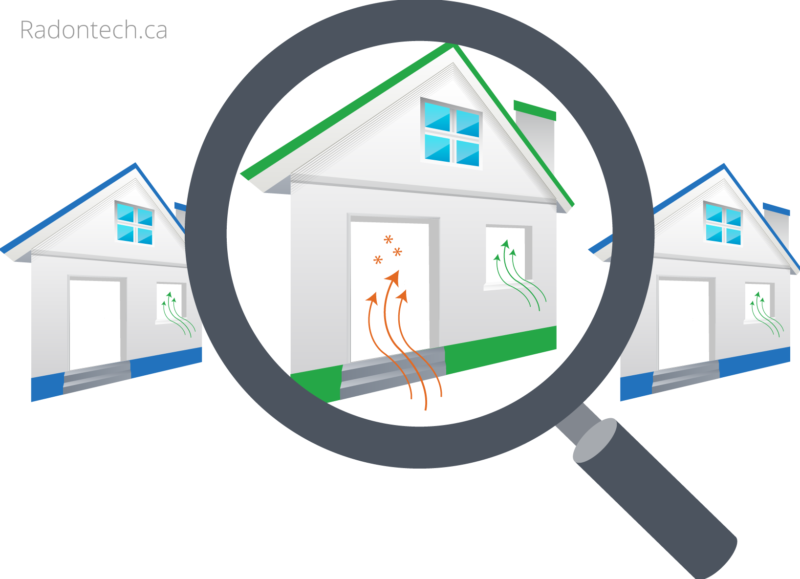Five Reasons Edmontonians Should Test Their Homes for Radon

Radon gas is a real thing, with real impact on real people’s lives. If you are considering testing your home for radon, you will be taking the first step towards safeguarding your family from the health effects of radon.
Health Canada recommends that every home in Canada should be tested for radon. You will understand why when you read the five reasons below. Testing is important because knowing the levels of radon in your home means you can take action if necessary. Testing for radon gas and reducing high radon levels is relatively easy. Radon is not like carbon monoxide where you have to get out of the home immediately. Its is long-term exposure to radon that matters, you will have some time to plan the fix.
In Edmonton, you can test for radon by using a radon gas test kit or hiring a certified radon measurement professional.
A recent Health Canada radon study of 18,000 homes in Canada found that there are no radon-free regions in Canada. A 2017 radon study from the University of Calgary found that 1 in 8 homes tested in the Calgary area have unsafe levels of radon gas.
High radon levels have been found in homes in almost all regions of Canada, including Edmonton. The only way to know your levels is to test.
A radon gas test should be part of the to-do list in every household in Edmonton; along with checking fire alarms and carbon monoxide detectors .
Here are five reasons why Edmontonians should consider testing their homes for radon:
1. Radon gas is the second leading cause for lung cancer
While the link between tobacco smoking and lung cancer gets the most press, Health Canada estimates that radon is responsible for about 16% lung cancer deaths in Canada; more than 3,000 deaths per year. This is more than motor vehicle accidents, fires, and drownings combined. Radon is the number one cause of lung cancer in non-smokers. The risk of developing lung cancer from radon exposure is significantly high for smokers. Radon exists everywhere in Canada, including Edmonton. And it exists to some extent in every home. The question is, how much is in your home? You need to know if you are being exposed to unsafe levels. The only way to know is to test your home.
2. We can’t smell, see or taste radon
We cannot detect radon with our senses. Even if radon was 100 times the acceptable limit, there would be nothing out of the ordinary. There are no definitive short-term symptoms of radon gas exposure. The only way to know is to test using a radon test kit or hiring a professional to do it for you.
3. It is relatively easy to test for radon
Radon testing is not like a renovation, carrying out a long term test will not interfere with your daily life. Radon testing equipment are typically a few inches long up to a foot maximum, it will not take much space. All the equipment used for radon testing is non-toxic and poses no health risk to homeowners. Health Canada has developed recommendations for testing protocols. Radon testing can be conducted using a DIY radon test kit, or hiring radon measurement professionals. The cost of an average long-term test is not steep; can range from $50-$75 for DIY kits to about $150-$350 for radon professionals.
4. Other than testing, there is no other way to determine radon levels
A recent Health Canada study estimated that about 7% of Canadian households have a high radon level, above recommended guidelines. That amounts to more than 20,000 households in Edmonton. Elevated radon gas concentrations can occur in any building regardless of age, heating system, foundation type, geographic location, air tightness, ventilation rate or building materials used. In addition, Radon levels have also been shown to vary greatly even among next door neighbours. Whether your neighbour’s radon levels are high or low, it has no bearing on your radon levels. The only way to know is to test your home.
5. There are effective ways to reduce radon in a building
If your house has radon levels above the guideline level (200Bq/m3 or more) it is recommended that you take action to reduce radon levels (radon mitigation). There are effective ways to do this depending on the structure of your house. The most common and effective radon mitigation method is sub-slab depressurization. This method basically involves drilling a hole in the slab of a basement and installing a vent pipe with a fan that draws the radon gas from under your house and pushes it outside. It is recommended to get a C-NRPP-certified contractor to carry out radon mitigation.
Being safe from the health risks of radon starts with knowing your radon levels through a radon test.
Read more about radon gas.
———
Radontech Solutions offers certified radon gas testing services in Edmonton & Area.

